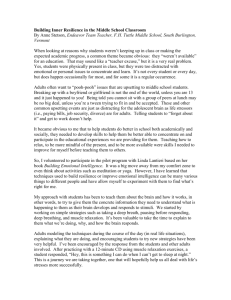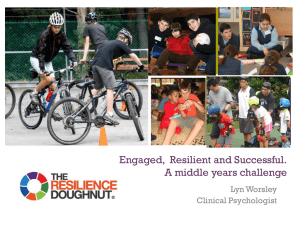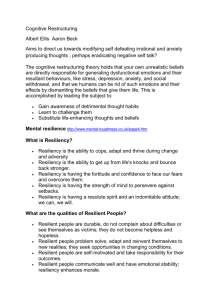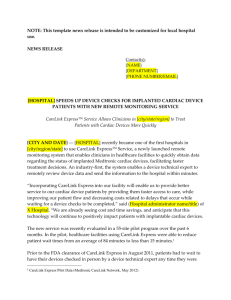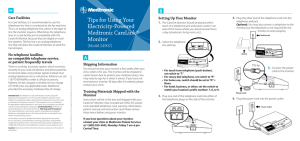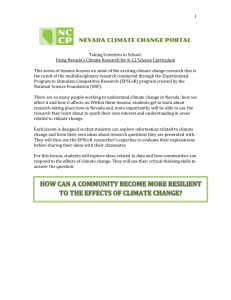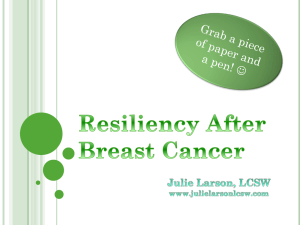PPT Presentation
advertisement
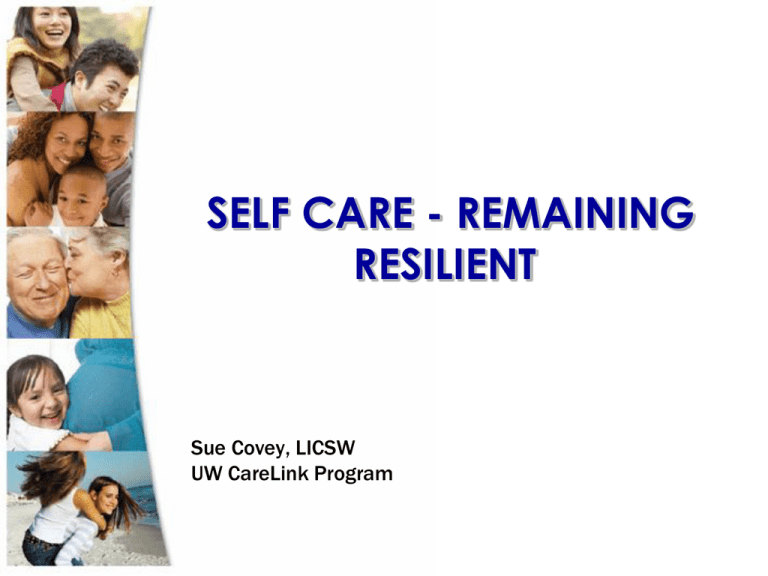
SELF CARE - REMAINING RESILIENT Sue Covey, LICSW UW CareLink Program Events over the past recent years that are anxiety provoking and may even feel frightening 1 Events on your home front scene are also challenging 2 REFLECT ON THE EVENTS OF THE PAST 1 – 2 YEARS THAT ARE OF CONCERN YOUR CURRENT SITUATION: WHAT ARE THE MOST RECENT “DEMANDS” THAT ARE NOW ON YOUR PLATE? 3 Put self on a scale from 1 to 10. 1______________________________10 1 = quite stressed; minimal resilience 10 = very resilient 4 Goals: Answer the following questions: What am I willing to do to move up “one notch” from how I am operating today? What do I do to perpetuate my own “distress” OR: What am I doing to decrease my resilience? 5 WHAT IS STRESS? STRESS = Reaction of your body to the demand(s) that are placed on it Our Perceptions Affect How We Cope with Change EVENT A PERCEPTION B THOUGHTS Beliefs Assumptions 8 FEEL C RESPONSE D COPING Physical Emotional Behavioral STRESS MANAGEMENT Inside job Eustress vs. Distress Effects on stress level Intensity Duration short-term prolonged Number of stressors Coping style and skills 9 What Are We Concerned About? Intensity of the stress Duration of the stress Constant / Repeated activation of the stress response (stressful life events experienced with little or no time to recover) 10 The Cumulative Nature of Stress 11 12 13 STRESS RESPONSE EVENT ANXIETY/TENSION HYPOTHALAMUS PITUITARY GLAND ADRENAL GLANDS SYMPATHETIC RESPONSE MAJOR ORGANS (lungs, liver, heart) INCREASE BLOOD to BRAIN & MUSCLES INCREASE ADRENALIN STAGES: ALARM; RESISTANCE; EXHAUSTION 14 STRESS = EXTERNAL + INTERNAL HOW MUCH CHANGE HAS OCCURRED IN THE PAST YEAR FOR YOU? THE CHALLENGE: TURNING DOWN THE WORRY THERMOSTAT & Finding Peace of Mind & Resilience During Uncertain Times 17 When Change Can’t be Controlled What can be controlled? What Can Be Controlled? Thoughts Feelings Behavior 19 MAINTAINING RESILIENCE AND DECREASING THE WORRY THERMOSTAT Thoughts Balanced Lifestyle Aware of Signals Relaxation Exercise Basic Needs 20 Resilient thinking 21 Stress-Resistant vs. Non Stress-Resistant People Pessimistic Explanatory Style Troubles = Permanent Troubles = Universal Only focus on what is wrong Internalize failures Optimistic Explanatory Style Troubles = Temporary Troubles = Specific Credit selves when things go right Externalize failures 22 The Power of Self Talk, Why It Can Be So Destructive 1. Remember, our body doesn’t know the difference from thinking about something and reality. 2. We are always talking to ourselves. Much of that is negative. If we say something to ourselves often enough, we tend to believe it. 3. We tend not to stop and question our thoughts, so our thinking becomes automatic. Developing Awareness of Our Self-Talk Keeping a journal of events, your reactions and feelings, and what you said to yourself about that event Look for evidence of distorted thinking 24 THE BALANCING ACT Inside: Self Emotional Physical Outside: Others Family Friends Community Job DECISION: WHAT’S IMPORTANT…….? Most difficult part? Juggling Exercise Stress –Typical Reactions/Signals Physical -sleeplessness -appetite Cognitive -memory -decision-making Emotional NEGATIVE SIGNS PHYSICAL: Nail biting Fidgeting Headaches Backaches Heartburn Clenched jaw Sleepiness Low energy Hot flashes Finger tapping NEGATIVE SIGNS EMOTIONAL: Mood Swings Depression Anxiety Crying Anger Withdrawal From Friends & Family Confusion and Forgetfulness NEGATIVE SIGNS OF STRESS MENTAL: Disorganized Poor concentration Memory lapses Self doubt Panicky Feeling inferior Defensive RELAXATION EXERCISE 31 BASIC NEEDS? WHAT ARE THEY? BASIC NEEDS Control Challenge Competency Support Appreciation Acceptance Self growth Feedback Recognition Friendship Self time Love/Affection NEGATIVE FEEDBACK LOOP Needs unmet: incompetent; inadequate; left out Worry thermostat goes up; self - esteem goes down fatigue decrease creativity decrease sense of humor anger, depression isolation from others Needs unmet 34 BRAIN “Should Driver” CRITICAL SELF TALK Should’s Have to’s Suppose to’s Got to Name calling PAIN ANGER DEPRESSION ILLNESS SOLUTION : WHAT ARE YOU WILLING TO DO? RELAXATION EXERCISE RESILIENT THINKING RESPONDING TO SIGNALS RE-BALANCING LIFE (JUGGLER) RECONSIDER: SHOULD’S versus WANT TO’S RECOGNIZE: BASIC NEEDS 38 Proven Strategies to Beat Stress and Maintain Vitality Practice one or more relaxation techniques Rest Exercise Proper nutrition Eat fruits/veggies--Fresh foods Eat whole grains Vitamin C & other essential nutrients Minimize sugar and caffeine Additional Strategies for Maintaining Vitality Nurture Your Sense of Humor. Develop a Spirit of Adventure – look for things that are going to energize you. Keep Your Focus – maintain your priorities. 40 STRESS BUSTER IDEAS Deep breathing Individual muscle relaxation Massage Meditation Exercise Yoga Music Therapy talking/Journaling 41 Breathe Slowly Deeply •Lowers blood pressure •Helps produce calm 42 Meditative Breathing to Vigorous Walking 43 Getting support from family and friends 44 UW CareLink Program The UW CareLink Faculty and Staff Assistance Program is a valuable resource CareLink is provided at no cost to you and your immediate family and household members Services are available on a per-issue basis allowing individuals to access the program as different needs arise Simply Call: 866-598-3978, 24 hours a day, 7 days a week, 365 days a year Available Services Services available to benefit eligible faculty and staff and their immediate family members Confidential Up to 5 counseling sessions per issue Financial/Legal Consultation & Referral Services Dependent Care and Daily Living Consultation and Referral www.apshelplink.com: Company code: UW EAP Counselors are available 24/7 Information, Referral, Follow-Up Management Consultation
